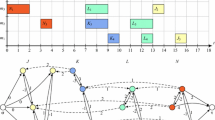Abstract
The proverb “a change is as good as a rest” expresses one of the main advantages of job rotation. In this article, we examine ways to set-up effective job rotation schedules that balance ergonomic risks among workers. The practical relevance of the problem is comprehensively discussed on examples from the automobile industry. We present the ergonomic job rotation scheduling problem and show that it is NP-hard in the strong sense. Therefore, the development of specialized solution methods is important. Exploiting the problem structure, we propose a fast and effective smoothing heuristic which can be integrated into solution methods for computing initial solutions and/or as a local re-optimization procedure. We find that integrating the smoothing heuristic into a suited tabu search approach is particularly recommendable. In computational experiments, this combination of approaches is able to solve almost all instances of a practical data set in very short computation times of some seconds, whereas the standard solver FICO Xpress and the best-known heuristic from literature perform considerably worse concerning computation time and solution quality.
Similar content being viewed by others
References
Bokranz R, Landau K (2006) Produktivitätsmanagement von Arbeitssystemen. Schäffer-Poeschel, Stuttgart
Boysen N, Fliedner M, Scholl A (2009a) Production planning of mixed-model assembly lines: overview and extensions. Prod Plan Control 20:455–471
Boysen N, Fliedner M, Scholl A (2009) Sequencing mixed-model assembly lines: survey, classification and model critique. Eur J Oper Res 192: 349–373
Burkhard R, Dell’Amico M, Martello S (2009) Assignment problems. Society for Industrial and Applied Mathematics, Philadelphia
Butković P, Lewis S (2007) On the job rotation problem. Discrete Optim 4: 163–174
Carnahan BJ, Redfern MS, Norman B (2000) Designing safe job rotation schedules using optimization and heuristic search. Ergon 43: 543–560
Cheng TCE, Sin CCS (1990) A state-of-the-art review of parallel-machine scheduling research. Eur J Oper Res 47: 271–292
Costa AM, Miralles C (2009) Job rotation in assembly line employing disabled workers. Int J Prod E 120: 625–632
De Werra D, Hertz A (1989) Tabu search techniques: a tutorial and an application to neural networks. OR Spectr 11: 131–141
Diego-Mas JA, Asensio-Cuesta S, Sanchez-Romero MA et al (2009) A multi-criteria genetic algorithm for the generation of job rotation schedules. Int J Ind Ergon 39: 23–33
EN 614-1 (2006) Safety of machinery—ergonomic design principles—Part 1: Terminology and general principles. European Committee for Standardization
Eklund JA (1995) Relationships between ergonomics and quality in assembly work. Appl Ergon 26: 15–20
Falck AC, Örtengren R, Högberg D (2010) The impact of poor assembly ergonomics on product quality: A cost-benefit analysis in car manufacturing. Hum Factors Ergon Manuf 20: 24–41
Garey MR, Johnson DS (1979) Computers and intractability: a guide to the theory of NP-completeness. W. Freeman and Company, New York
Glover F (1990) Tabu search: a tutorial. Interfaces 20: 74–94
Jorgensen M, Davis K, Kotowski S, Aedla P, Dunning K (2005) Characteristics of job rotation in the Midwest US manufacturing sector. Ergon 28: 1721–1733
Keir PJ, Sanei K, Holmes MWR (2011) Task rotation effects on upper extremity and back muscle activity. Appl Ergon 42: 814–819
Kuijer PPFM, Visser B, Kemper HCG (1999) Job rotation as a factor in reducing physical workload at a refuse collecting department. Ergon 42: 1167–1178
Kuijer PPFM, van der Beek AJ, van Dieën JH, Visser B, Frings-Dresen MHW (2005) Effect of job rotation on need for recovery, musculoskeletal complaints, and sick leave due to musculoskeletal complaints: a prospective study among refuse collectors. Am J Ind Med 47: 394–402
Lodree EJ, Geiger CD, Jiang X (2009) Taxonomy for integrating scheduling theory and human factors: Review and research opportunities. Int J Ind Ergon 39: 39–51
Longo F, Mirabelli G (2009) Effective design of an assembly line using modelling and simulation. J Simul 3: 50–60
Moreau M (2003) Corporate ergonomics programme at automobiles Peugeot-Sochaux. Appl Ergon 34: 29–34
Neumann WP, Winkel J, Medbo L, Magneberg R, Mathiassen SE (2006) Production system design elements influencing productivity and ergonomics. Int J Oper Prod Manag 26: 904–923
Occupational Safety and Health Administration (2000) Final Ergonomics Program Standard. Federal register #64, pp 65768–66078
Osterman P (2000) Work reorganization in an era of restructuring: trends in diffusion and effects on employee welfare. Ind Labor Relat Rev 53: 176–196
Otto A, Scholl A (2011) Incorporating ergonomic risks into assembly line balancing. Eur J Oper Res 212: 277–286
Raina SM, Dickerson CR (2009) The influence of job rotation and task order on muscle fatigue: a deltoid example. Work 34: 205–213
Rissén D, Melin B, Sandsjö L, Dohns I, Lundberg U (2002) Psychophysiological stress reactions, trapezius muscle activity, and neck and shoulder pain among female cashiers before and after introduction of job rotation. Work Stress 16: 127–137
Schaub K, Caragnano G, Britzke B, Bruder R (2010) The European Assembly Worksheet. In: Mandelo P, Karwowski W, Saarela K, Swuste P, Occhipinti E (eds) Proceedings of the VIII international conference on occupational risk prevention, Valencia, 5–7 May 2010
Sinn-Behrendt A, Schaub K, Winter G, Landau K (2004) Ergonomisches Frühwarnsystem ,,Ergo-FWS“. In: Landau K (ed) Montageprozesse gestalten: Fallbeispiele aus Ergonomie und Organisation, Ergonomia, Stuttgart
Seçkiner SU, Kurt M (2007) A simulated annealing approach to the solution of job rotation scheduling problems. Appl Math Comput 188: 31–45
Seçkiner SU, Kurt M (2008) Ant colony optimization for the job rotation scheduling problem. Appl Math Comput 201: 149–160
Tharmmaphornphilas W, Norman BA (2004) A quantitative method for determining proper job rotation intervals. Ann Oper Res 128: 251–266
Tharmmaphornphilas W, Norman BA (2007) A methodology to create robust job rotation schedules. Ann Oper Res 155: 339–360
Walter R (2011) Comparing the minimum completion times of two longest-first scheduling-heuristics. Central Eur J Oper Res. doi:10.1007/s10100-011-0217-4
Author information
Authors and Affiliations
Corresponding author
Rights and permissions
About this article
Cite this article
Otto, A., Scholl, A. Reducing ergonomic risks by job rotation scheduling. OR Spectrum 35, 711–733 (2013). https://doi.org/10.1007/s00291-012-0291-6
Published:
Issue Date:
DOI: https://doi.org/10.1007/s00291-012-0291-6




